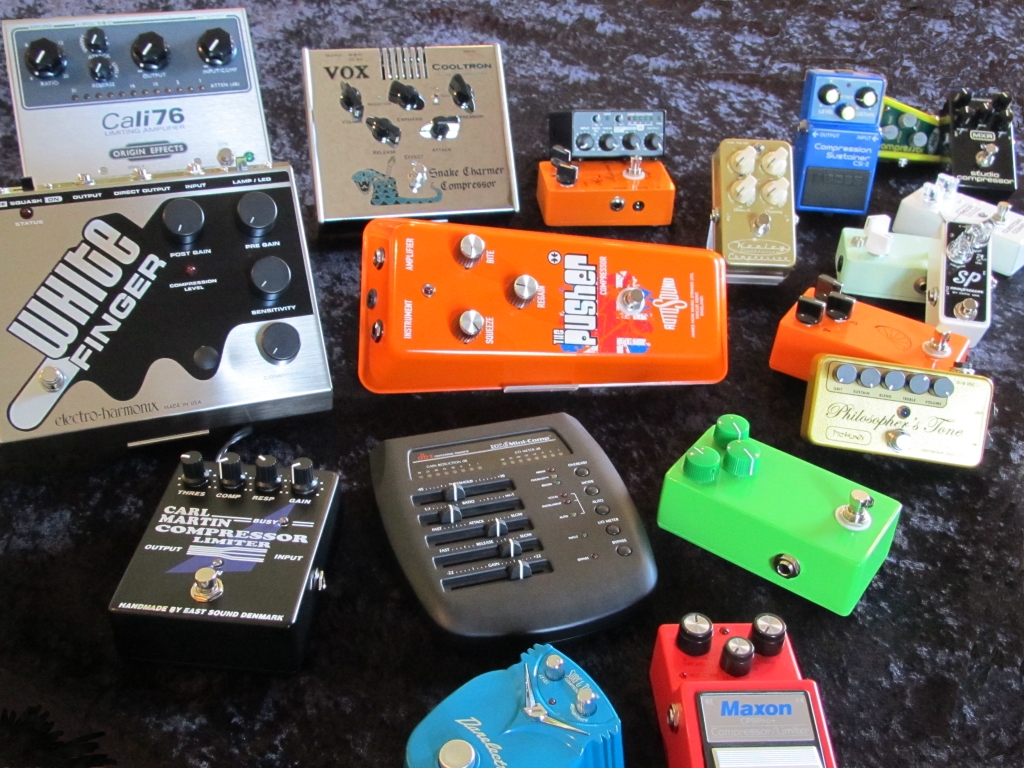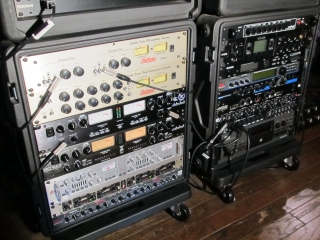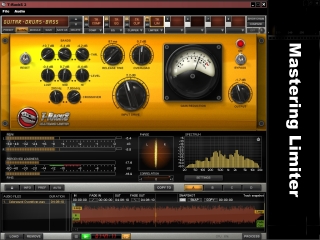
Compression and Limiting :
In simplified terms, a compressor’s main function is to balance loud and soft volume levels to be heard in equal proportion. As well, a compressor is also capable of creating longer sustain (i.e., musical notes will not fade away so quickly). Yet, another application for employing a compressor may be to increase it’s ratio amount—creating a powerful sonic illusion for individual musical instruments, and/ or an entire sound mix. Also as result of applying compression, such will always create a smooth character in relation to whatever sound it effects. Conversely, without employing compression (and/ or, limiting), such will sound non-professional and harsh.

Musicians, audio engineers and music producers generally, rely upon compression (in part) to achieve a “polished” end-result. These specialized devices are available in different formats : pro-audio (i.e., studio rack-mount units, or software), and effects pedals (incl. software versions). I myself, rely upon all of the aforementioned types as needed. In fact . . as a guitarist, I could not achieve my level of talent without employing a compressor. Ultimately, such is a subtle “feel” effect, more than an obvious one; which helps me reach for my favorite notes. If you decide to experiment with an audio compressor, please understand that you will have to get a feel for the experience. Otherwise, in relation to my pro-audio needs, I could not achieve a professional-sounding result without one; as my sound mixes are thus enhanced, providing an illusion of greater size and power—incl. having balanced the overall dynamic range, and smoothing any harshness thereof.

In a similar manner, a limiting device (or a limiting control, as part of a compressor’s feature set) is employed to limit volume (dB) level, so that such will not exceed a preset threshold amount (i.e., +0 dB/ unity gain)—thus, preventing loud peaks/ spikes from occurring. In a relative sense, limiting can be employed to protect an overly-powerful dB level from damaging loud speakers. Otherwise, a particular application for the limiting sound process may also, be to intentionally create the illusion of a rather loud (albeit safe) and powerful sound character for drums, and/ or an entire sound mix; generally, employed for heavy genres of music—i.e., Rock and Metal. Incidentally . . radio stations employ a limiter to create this illusion, so that music is perceived as more exciting/ energetic; though, an excess of compression and/ or limiting will be counter-productive to the dynamics of any sound source—i.e., “squashing” said audio. Conversely, the Classical genre of music is never compressed, relative it’s dynamic volume levels needing to remain intact for full effect. As for acoustic guitar, bass guitar, vocals, and drums, only a gentle amount of limiting may be all that’s necessary to maintain a smooth and balanced sound.
NOTE : Sound processing designed to change the sonic character of music will also, have an effect on musical tonality as well—as oppose, to solely being intended for practical/ technical applications.
Types of compression and limiting technologies :
Tube/ Valve : 1950s-1960s era analog, employing electron vacuum tubes to produce a warm, smooth, and “3-dimensional” sonic character.
Optical : 1960s era analog, employing an actual light source to produce a very soft and rather transparent (“colorless”) result.
FET/ Field Effect Transistor : 1960s era analog, “replacing” the former optical design and creating a similar result.
VCA/ Voltage-Controlled Amplifier : 1970s era analog, capable of producing subtle or very aggressive results—though not as dimensional, nor warm.
Digital : 1980s-to-present era, providing both precision and transparency—though not as dimensional, nor warm.
Digital/ Vintage-Modeling : 1990s-to-present era, approximating that of the above-mentioned analog processing technologies.
Epilogue :
To the average home studio enthusiast, what’s been mentioned herein, must seem rather involved. As you realize by reading this post, such is NOT merely twiddling knobs on effects pedals. Rather . . such is to show how effects pedals enhance music recordings, along with pro-audio gear.
This Website :
The intention of fuzz-effect-sounds-and-more.com is to provide a reference resource; virtually sharing my gear collection, so that readers are made greater-aware of particularly good-sounding (and, in some instances), potentially collectible effects pedals. Otherwise, to also help those whom might benefit from my recording/ engineering techniques. Ultimately, as I continue to build and design this site, I will gradually introduce additional collection-based content—such as blog posts, image galleries, audio, video, and official manufacturer web links for your convenience. The information provided herein, is based upon biased opinion. Please, do your own research.
Ebooks :
Later . . I will offer for sale Part 1 of a series of self-authored eBooks, in relation to fuzz effects pedals; subsequently, also offering additional volumes regarding other effects types—boost, overdrive, distortion, etc—all via my private, independent collection. Moreover, these tomes of tone will include audio examples, color images, (in most cases) close-up circuit views, and generalized spec. information. Otherwise, said eBooks regarding fuzz effects pedals will additionally incl. generalized historical information as well. For details, please read this site’s eBook advertisement page.
THANK YOU for your interest of fuzz-effect-sounds-and-more.com
– Michael.
Disclaimer of Copyright & Trademark :
Product names, trademarks, and artists’ names (incl. the names of builders and designers) referred to, and/ or depicted herein are the property of their respective owners, which are in NO way associated or affiliated with fuzz-effect-sounds-and-more.com. Said, names and trademarks are used solely to identify products whose sounds were studied during the audio production efforts for this reference resource. The use of said, names and trademarks does NOT imply any cooperation or endorsement. NO copyright, nor trademark infringement intended. Any errors, omissions or variations in the subject-matter details are unintentional.
Disclaimer of External Web Links :
EXTERNAL web links are provided as a convenience, and for informational purposes only; they do NOT constitute an endorsement or an approval by fuzz-effect-sounds-and-more.com of any of the products, services or opinions of the corporation or organization or individual. fuzz-effect-sounds-and-more.com bears NO responsibility for the accuracy, legality or content of the external site or for that of subsequent links. Contact the external site for answers to questions regarding its content.

This Website & Its Contents : Copyright © fuzz-effect-sounds-and-more.com